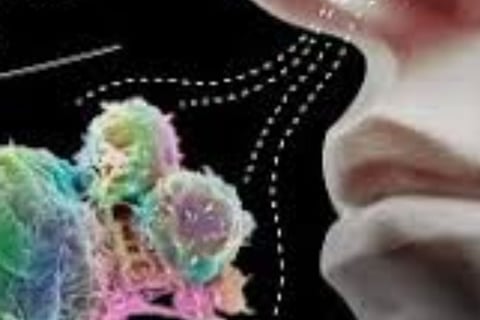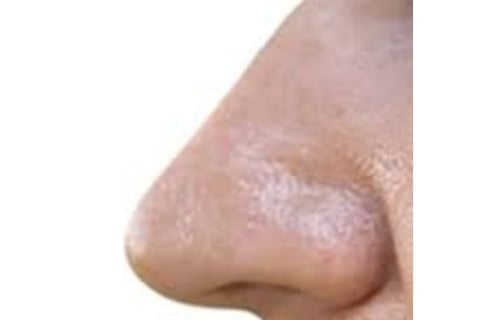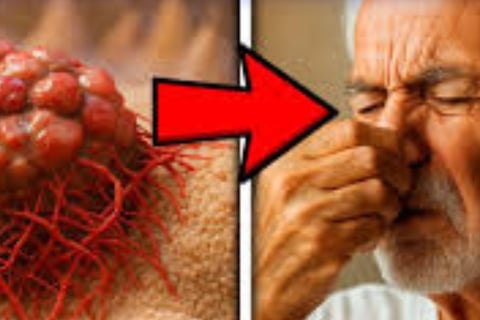
Health is a crown on the heads of the healthy that only the sick can see.

🧠👃 The Nose Knows : Exploring the Strange Smell Linked to Cancer
🧠👃 What if your nose could detect disease? Explore the science behind the strange smell linked to cancer, how the body emits odor changes, and the groundbreaking research into using scent for early diagnosis. 🧬🐶
CANCER
Dr Hassan AlWarraqi
6/30/2025


🧠👃 The Nose Knows : Exploring the Strange Smell Linked to Cancer
🧠👃 What if your nose could detect disease? Explore the science behind the strange smell linked to cancer, how the body emits odor changes, and the groundbreaking research into using scent for early diagnosis. 🧬🐶
The Mysterious Smell of Cancer: Unraveling the Science Behind Disease Odors
The concept that cancer might have a distinctive smell has fascinated scientists and medical professionals for years.
While largely undetectable to human noses, growing evidence suggests that cancerous cells do produce unique volatile organic compounds (VOCs) that can potentially serve as biomarkers for early detection.
This phenomenon represents an intriguing intersection of oncology, biochemistry, and sensory science that could revolutionize cancer screening methods.
The Science of Cancer Odors
Cancer cells produce distinct volatile organic compounds (VOCs) as byproducts of their abnormal metabolic processes.
These VOCs result from the uncontrolled cellular division characteristic of cancer, where cells multiply too rapidly and fail to die when they should.
This abnormal process leads to the death of healthy cells and biochemical changes that generate unique odor signatures
Researchers have identified several key compounds associated with cancer odors:
Polyamines: Molecules associated with rapid cell growth and proliferation that are produced at higher levels in cancer cells.
These have a distinct smell detectable in blood and urine
Hydrogen sulfide: Found in colorectal cancer cells, producing a rotten egg-like odor
Unique VOC patterns: Different cancer types release specific combinations of VOCs that form identifiable "odor signatures"
These chemical signatures are released through various bodily fluids and emissions including breath, urine, blood, and even through the skin in cases of surface tumors
The composition and concentration of these VOCs vary depending on cancer type, location, and stage, creating unique olfactory profiles for different malignancies
Can Humans Smell Cancer?
While the average person cannot detect the subtle VOC patterns associated with cancer, there are specific circumstances where humans might notice odor changes:
Ulcerating tumors: When cancerous growths break through the skin surface, they can become infected, producing noticeable foul odors from necrotic tissue and bacterial activity .
Several breast cancer patients reported persistent underarm odors that resolved after tumor removal .
Cervical cancer: May cause noticeable changes in vaginal discharge odor, described as unpleasant or foul .
Oral cancers: Can lead to detectable breath changes when combined with other symptoms like mouth sores or lumps .
Anecdotal reports from cancer patients and survivors describe various olfactory experiences:
A persistent ammonia-like smell preceding breast cancer diagnosis
Underarm body odor changes that couldn't be eliminated by washing
Sweet-smelling episodes reported by some patients with advanced cancer
However, these human-detected odors are typically associated with late-stage or complicated cases rather than early detection .
Most cancer-related VOCs remain below human detection thresholds without specialized equipment .
Canine and Electronic Detection
Dogs have demonstrated remarkable ability to detect cancer through smell, with some studies showing:
98% accuracy when using both breath and urine samples
87% accuracy with urine samples alone
97% accuracy in detecting ovarian cancer from blood samples
Dogs have successfully identified various cancer types including:
Melanoma (through skin lesions)
Colorectal cancer (from breath and stool samples)
Lung cancer (from breath and urine samples)
Ovarian and prostate cancers (from blood and urine respectively)
Breast cancer (from urine samples)
Researchers are working to develop "electronic nose" technology that can replicate canine olfactory capabilities.
Current prototypes have achieved up to 84% accuracy in detecting ovarian cancer VOCs, showing promise but not yet matching canine performance .
These devices analyze "smell print profiles" from urine or breath samples to identify cancer-specific VOC patterns
Odor Changes from Cancer Treatments
While cancer itself may produce subtle odors, treatments often cause more noticeable smell changes:
Chemotherapy effects:
Alters urine odor, making it stronger and more unpleasant
Causes dry mouth leading to bad breath from mouth sores and reduced saliva
May make patients more sensitive to smells, causing food aversions
Some chemotherapy drugs have distinct odors that patients may notice
Radiation therapy effects:
Head/neck radiation can damage olfactory nerves, affecting smell long-term
May reduce saliva production, contributing to taste and smell changes
Surgical effects:
Nasal packing after sinus surgery temporarily eliminates smell
Removal of odor-producing tumors resolves associated smells
These treatment-related odor changes are typically temporary, resolving within weeks to months after therapy concludes
Clinical Applications and Future Directions
The potential medical applications of cancer odor detection are significant:
Early detection screening: Developing non-invasive tests using breath, urine, or blood samples to identify cancer-specific VOC patterns before symptoms appear
Diagnostic adjuncts: Creating portable electronic nose devices that could be used in clinical settings to assist diagnosis
Treatment monitoring: Tracking VOC changes during therapy to assess treatment response
Recurrence surveillance: Monitoring cancer survivors for reappearance of disease-specific VOC patterns
Current challenges include:
Standardizing detection methods across cancer types
Differentiating cancer VOCs from other disease processes
Improving electronic nose accuracy to match canine capabilities
Establishing clinical protocols for odor-based testing
Managing Odor-Related Concerns
For patients experiencing noticeable odor changes:
For treatment-related odors:
Maintain excellent oral hygiene to combat bad breath
Stay hydrated to dilute strong urine odors
Change bedding frequently to reduce accumulated smells
Bathe regularly to manage sweat and medication odors
For ulcerating tumors:
Seek medical care for antibiotics to treat infections
Have dead tissue professionally removed from wounds
Keep affected areas clean and properly moisturized
For sensory changes:
Experiment with different food textures and temperatures
Try spicy foods to compensate for reduced taste
Practice smell retraining if olfactory nerves are intact
Safety considerations for smell loss:
Install smoke detectors throughout living spaces
Consider electric alternatives to gas appliances
Carefully read chemical product labels
Conclusion
The mysterious smell of cancer represents both a scientific frontier and potential diagnostic breakthrough.
While humans generally cannot detect cancer through smell alone, the unique VOC patterns produced by malignant cells offer promising avenues for early detection through canine and electronic nose technologies.
Current research continues to refine our understanding of these olfactory signatures across different cancer types, with the goal of developing reliable, non-invasive screening methods.
For now, noticeable odor changes in patients are more likely related to treatment effects or advanced disease rather than early warning signs.
As this field advances, odor-based detection may someday become a standard tool in the fight against cancer, potentially saving lives through earlier diagnosis and intervention.
For those experiencing concerning odor changes, particularly in combination with other symptoms, consulting healthcare providers remains essential for proper evaluation and care .
The ongoing research into cancer's olfactory signatures reminds us of the complex ways our bodies communicate disease - sometimes through senses we're only beginning to understand.
that certain cancers may produce distinct odors detectable by humans or animals, though the topic is complex and not fully understood.
Here's a concise breakdown
Biological Basis: Cancer cells can alter metabolism, releasing volatile organic compounds (VOCs) that may produce unique odors.
These compounds can be emitted through breath, sweat, urine, or skin.
For example, lung cancer might affect breath odor, while skin cancers could alter body scent.
Detection by Animals: Studies, like those referenced in web sources, show trained dogs can detect specific cancers (e.g., lung, breast, or prostate cancer) by smelling breath, urine, or tissue samples with high accuracy.
This is due to their ability to sense VOCs at extremely low concentrations.
Human Perception: Some anecdotal reports, like those on forums such as Cancer Research UK, mention people noticing unusual smells (e.g., "rotten" or "chemical-like") from loved ones with cancer, though these are not consistent or diagnostic.
Scientific Limitations: While promising, odor-based detection is not a standard diagnostic tool.
VOC profiles vary across cancer types, stages, and individuals, making it hard to pinpoint a universal "cancer smell." Research is ongoing but not conclusive enough for clinical use.
Cultural and Historical Context: The idea of disease-specific odors isn't new—ancient medicine often linked smells to illness. Modern interest, as seen in posts on X, often ties to curiosity about alternative diagnostics but can be speculative or exaggerated.
🧠👃 FAQs: The Mysterious Smell of Cancer
1. Can cancer really produce a distinct smell?
Yes, cancer cells release volatile organic compounds (VOCs) due to abnormal metabolism. These can create unique odor signatures—though often too subtle for the human nose to detect without aid.
2. What are VOCs and how are they linked to cancer?
Volatile Organic Compounds (VOCs) are chemicals released by cells, including cancerous ones, during metabolic processes. Different cancers emit different VOC profiles, which may be detectable in breath, urine, blood, or skin emissions.
3. Can humans smell cancer?
In rare cases, yes. For example, ulcerating tumors or advanced-stage cancers may emit noticeable foul odors due to necrotic tissue and bacterial infection. However, early-stage cancer VOCs are typically imperceptible without tools or trained animals.
4. What types of cancer are most associated with odor changes?
Odor has been reported in:
Breast cancer (e.g., persistent underarm odor)
Cervical cancer (foul-smelling vaginal discharge)
Oral cancers (bad breath with other symptoms)
Skin cancers (odor from open or infected lesions)
5. Can dogs really sniff out cancer?
Yes. Trained dogs have demonstrated over 90% accuracy in detecting several types of cancer (like lung, breast, and ovarian) by sensing VOCs in breath, urine, or blood samples.
6. What is an “electronic nose” and how does it detect cancer?
An electronic nose is a device designed to mimic the canine sense of smell.
It analyzes “smell-print” patterns of VOCs to potentially detect cancers non-invasively. It's still under development but shows promising results.
7. Do cancer treatments affect body odor?
Yes. Chemotherapy and radiation can alter body odor by affecting saliva production, causing dry mouth, changing urine smell, and increasing sensitivity to existing odors. Some drugs even have distinctive smells.
8. Is smell-based cancer detection used clinically today?
Not yet. While research is promising, odor detection is not a standard diagnostic tool. More studies are needed to confirm accuracy and consistency across cancer types.
9. Could smell changes be an early sign of cancer?
Not typically. Most odor changes linked to cancer occur in advanced or complicated stages. If you notice unusual persistent odors, especially with other symptoms, it’s important to consult a healthcare professional.
10. What’s the future of cancer smell research?
The field is growing rapidly.
Scientists aim to develop non-invasive, VOC-based screening tests using breath or urine.
These could one day detect cancer earlier and more comfortably than current methods.
keywords
The mysterious smell of cancer involves volatile organic compounds (VOCs) produced by abnormal cancer cell metabolism, detectable through specialized means like canine olfaction (with dogs showing 98% accuracy in studies) and emerging electronic nose technology, though rarely noticeable to humans except in cases like ulcerating tumors or treatment side effects (chemotherapy-induced odor changes, radiation affecting smell). Meanwhile, Islamic voluntary fasting (nafl) follows specific rules—recommended during Shawwal, Dhul-Hijjah, and Mondays/Thursdays but prohibited on Eids and Tashreeq days—with flexible intention timing and breakability unlike obligatory fasts, offering spiritual rewards through practices like the Prophet Dawood's alternate-day fasting. Both topics explore hidden sensory dimensions—one in disease detection, the other in spiritual discipline.












